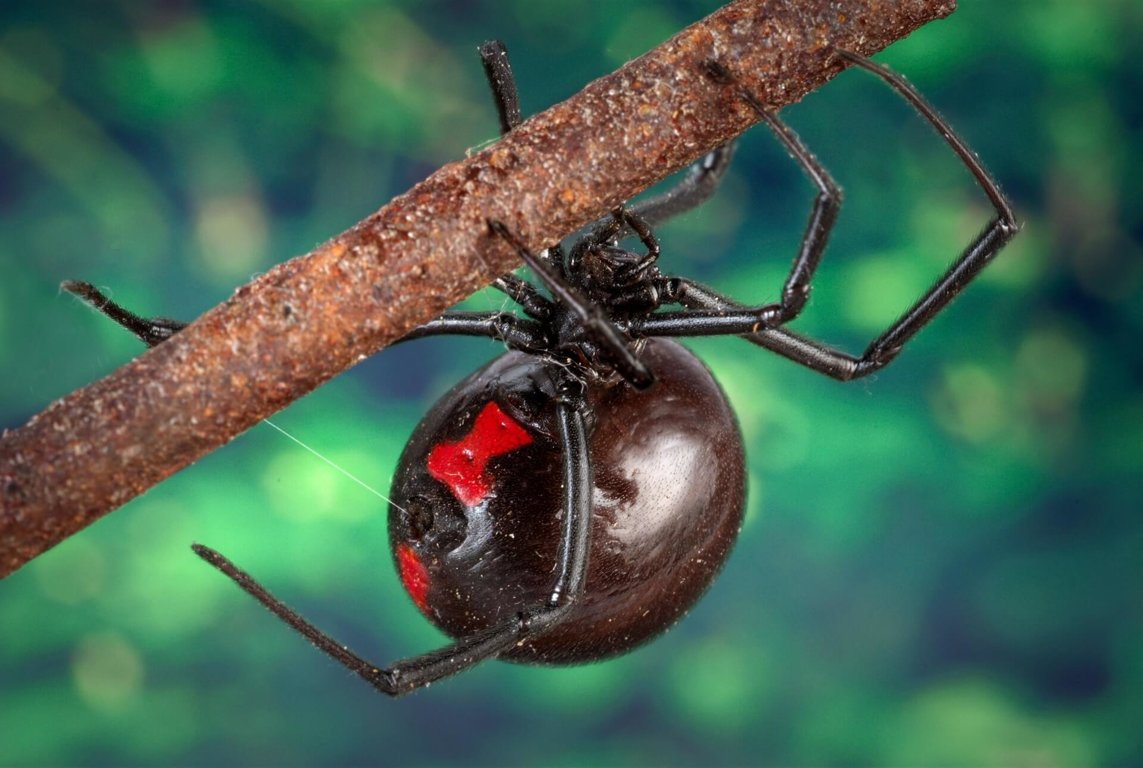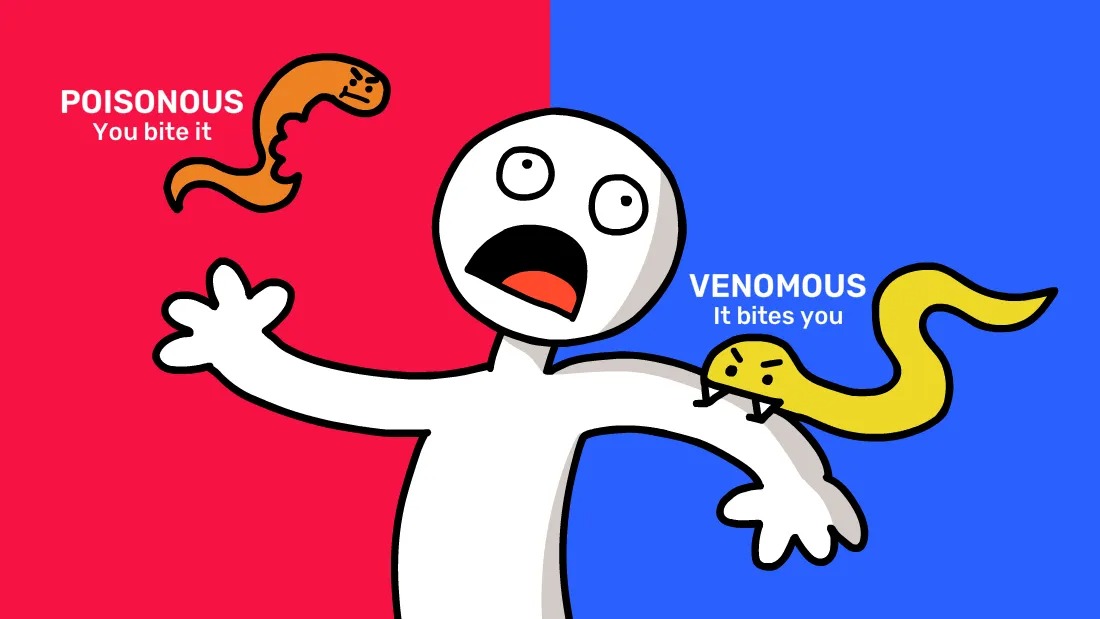People have been confusing the words poisonous and venomous for as long as humans have been telling stories about dangerous animals. The mix-up is so common that even scientists and wildlife experts hear the terms used interchangeably in everyday conversation. If you encounter a snake on a trail, a brightly colored frog in the jungle, or a strange creature in the ocean, the first question that usually comes to mind is simple: is it poisonous or venomous—and does that difference actually matter?
It does. And in nature, that difference shapes how animals hunt, defend themselves, and interact with their environment in ways that are far more complex than most people realize. Poison and venom are not just labels; they represent two distinct evolutionary strategies that determine how toxins move from one organism to another. The danger is not only in how strong a toxin is, but in how it is delivered, how fast it acts, and how likely it is to come into contact with another animal.
At a basic level, both poisonous and venomous animals rely on toxins—chemical compounds that disrupt normal biological functions. These substances can shut down nerves, destroy tissue, stop the heart, interfere with blood clotting, or trigger violent immune reactions. Yet the similarities largely end there. Some animals must bite, sting, or jab to deliver their toxins. Others never attack at all, instead turning their own bodies into chemical warning signs that punish predators for making the wrong choice.
The natural world does not draw clean lines, either. Some species bend the rules, combining multiple toxin strategies or using delivery systems that fall somewhere between poison and venom. Others acquire toxins from their diet instead of producing them themselves, blurring the boundary between biology and chemistry. What seems like a simple vocabulary question quickly becomes a window into how evolution experiments with survival.
Understanding the difference between poisonous and venomous animals isn’t just about using the correct word. It helps explain why bright colors signal danger, why some animals must be handled with extreme caution even after death, and why a bite, a touch, or a mouthful can each lead to very different outcomes. In the wild, these distinctions can mean the difference between a mild warning and a fatal mistake.
What Is the Difference Between Poisonous and Venomous Animals?
Poison and venom: similar weapons, different delivery
Venomous and poisonous animals use toxins for the same fundamental reasons: defense and predation. Both strategies allow animals to deter predators, immobilize prey, or gain an advantage without relying on size or strength. However, the way these toxins are deployed shapes how each animal behaves and interacts with its environment.
Venomous creatures—including snakes, spiders, wasps, and scorpions—must physically wound another organism to deliver their toxins. This means their venom systems are often highly complex, involving glands, ducts, and delivery structures that bypass the digestive system entirely. Poisonous animals, on the other hand, depend on the toxin being absorbed through the skin or digestive tract of a predator, often as a last line of defense.
Because poisonous animals do not attack, their toxins are almost always defensive in nature. Venomous animals may use toxins offensively as well, subduing prey quickly and efficiently.
Pick your poison
Poisonous species deploy their toxins strictly as a defensive mechanism, helping them avoid being eaten. According to biologists who study animal toxins, poisonous animals rely on deterrence rather than aggression. Their toxins are designed to make predators sick, disoriented, or dead after contact or ingestion.
Once a toxin is ingested, it can spread rapidly through the predator’s body, producing effects that range from nausea and vomiting to paralysis or death. The severity depends on the type of toxin and the amount absorbed. Some poisons act quickly, while others build up over time.
Pufferfish are a classic example of this strategy. They contain tetrodotoxin in their skin and internal organs, a neurotoxin far more potent than cyanide. Predators that attempt to eat a pufferfish often die as a result, learning a fatal lesson that benefits the species as a whole.
Many poisonous animals do not manufacture their toxins themselves. Instead, they acquire them from their environment. Pufferfish obtain tetrodotoxin from marine bacteria, while monarch butterflies accumulate toxins from milkweed plants consumed during their caterpillar stage. These chemicals are then stored in their tissues, making them distasteful or lethal to predators.
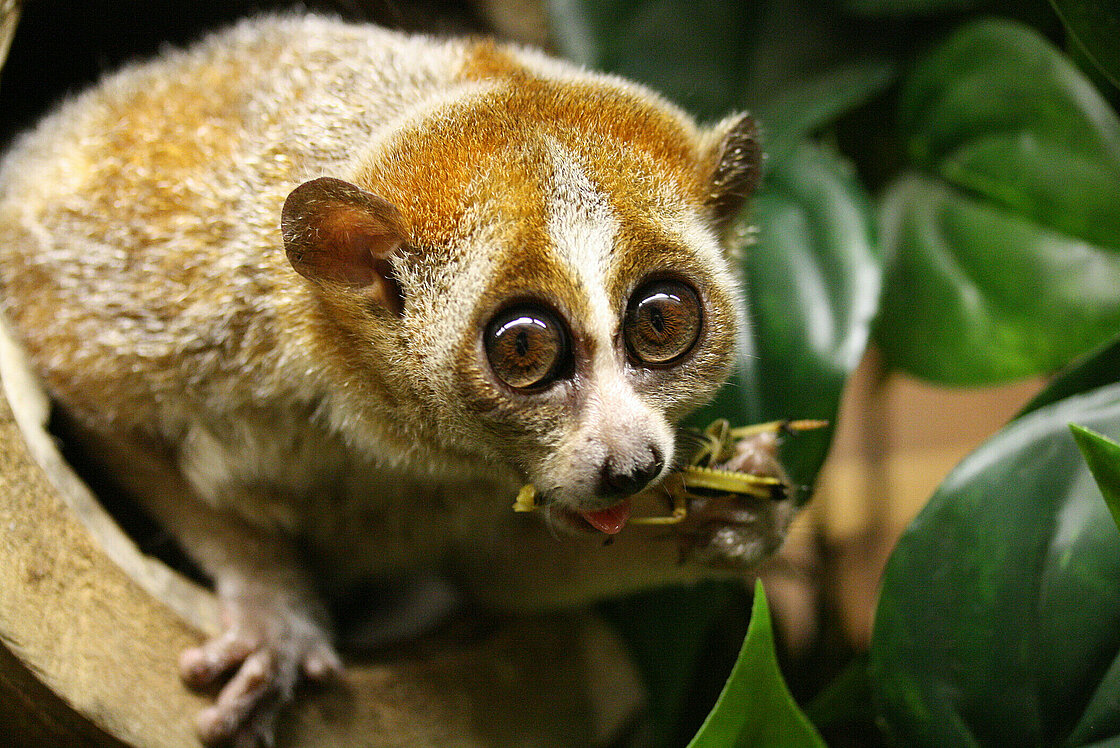
Warning coloration is another common feature among poisonous animals. Bright, contrasting colors serve as visual signals that advertise toxicity. Poison dart frogs in Central and South America are among the most famous examples, displaying vivid blues, yellows, and reds that signal danger long before contact occurs.
Researchers have identified a wide range of neurotoxic alkaloids in these frogs, some mildly irritating and others extremely lethal. The golden poison frog, native to Colombia, is one of the most toxic animals known. Its skin secretes batrachotoxin, a substance likely derived from beetles in its diet. A single frog carries enough toxin to kill several adult humans.
Similar dietary toxin transfer is thought to explain the poisonous feathers of the hooded pitohui bird in Papua New Guinea, which also carries batrachotoxin. In these cases, poison becomes a shared ecological currency, moving through food webs and shaping survival strategies across species.
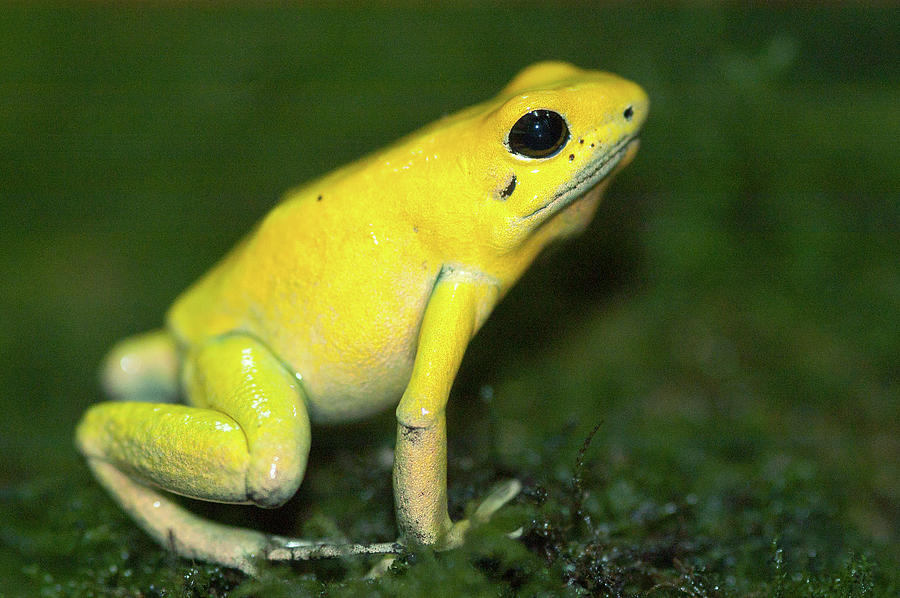
Bites, stings, and direct injection
Venomous animals take a far more active approach. Because venom must be delivered directly into another organism’s body, venom systems are usually produced by the animal itself and are biologically intricate. Venom bypasses digestion entirely, entering the bloodstream or tissues through wounds.
Many venomous animals rely on bites to deliver toxins. Snakes and spiders inject venom through hollow fangs that disable prey by attacking the nervous or circulatory systems. In some species, venom also begins digesting prey from the inside, making consumption easier.
Nature has produced many variations on this theme. Some lizards, including the Komodo dragon, appear to possess venomous saliva that causes blood loss and shock in bitten prey. The solenodon, a rare mammal from the Caribbean, also delivers venom through grooves in its teeth.
Marine species have developed equally specialized systems. Cone snails use a modified tooth as a venomous harpoon, injecting powerful toxins capable of killing animals much larger than themselves.
Other animals use stingers or spines rather than teeth. Stonefish store venom in spines along their dorsal fins, delivering it when stepped on. Certain frogs even use spines on their heads to drive toxins into attackers during defensive strikes.
Stranger still is the venom system of the slow loris, a nocturnal primate from Southeast Asia. These animals produce toxins in glands located beneath their upper arms. When threatened, a loris licks these glands and delivers the toxin through a bite.
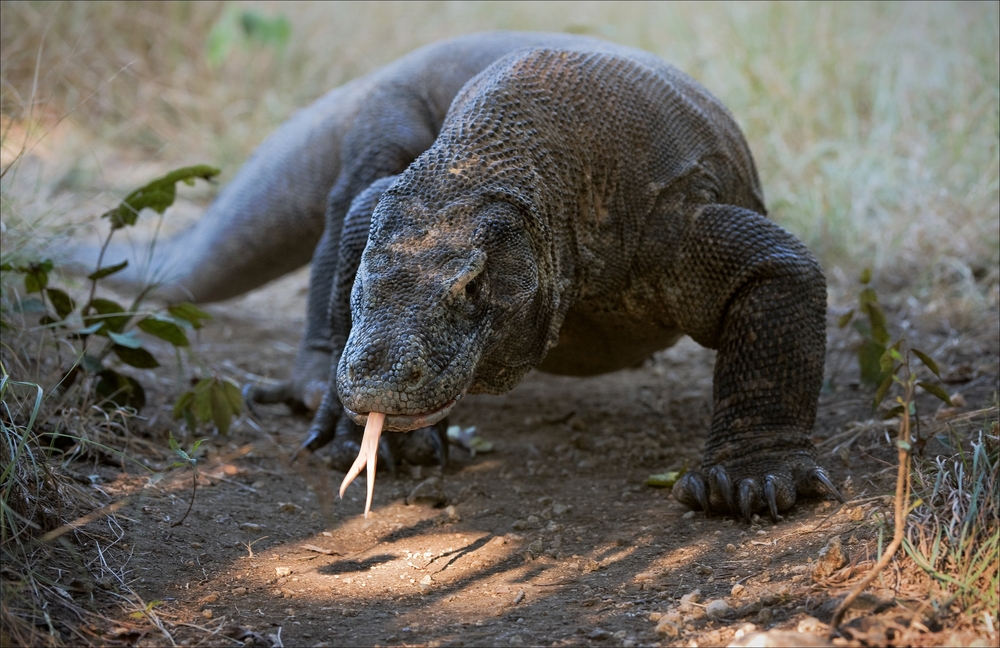
In humans, venom from slow lorises can trigger severe immune reactions, including intense pain, tissue damage, and anaphylactic shock.
A third way toxins are delivered
Between the classic categories of poisonous and venomous animals, scientists have identified a third, less familiar strategy for toxin use. These animals are described as toxungenous. Rather than waiting to be eaten or injecting venom through a bite or sting, toxungenous animals actively project their toxins outward toward a threat.
This method allows an animal to keep distance from predators while still delivering a powerful chemical deterrent. The toxins may be sprayed, flung, or ejected with surprising accuracy, often targeting sensitive areas such as the eyes, nose, or mouth.
Some insects provide dramatic examples. Bombardier beetles eject hot, irritating chemicals from their abdomens in rapid bursts, producing both heat and toxic fumes. Fire salamanders can spray poisonous secretions from skin glands over considerable distances, deterring predators before physical contact occurs.
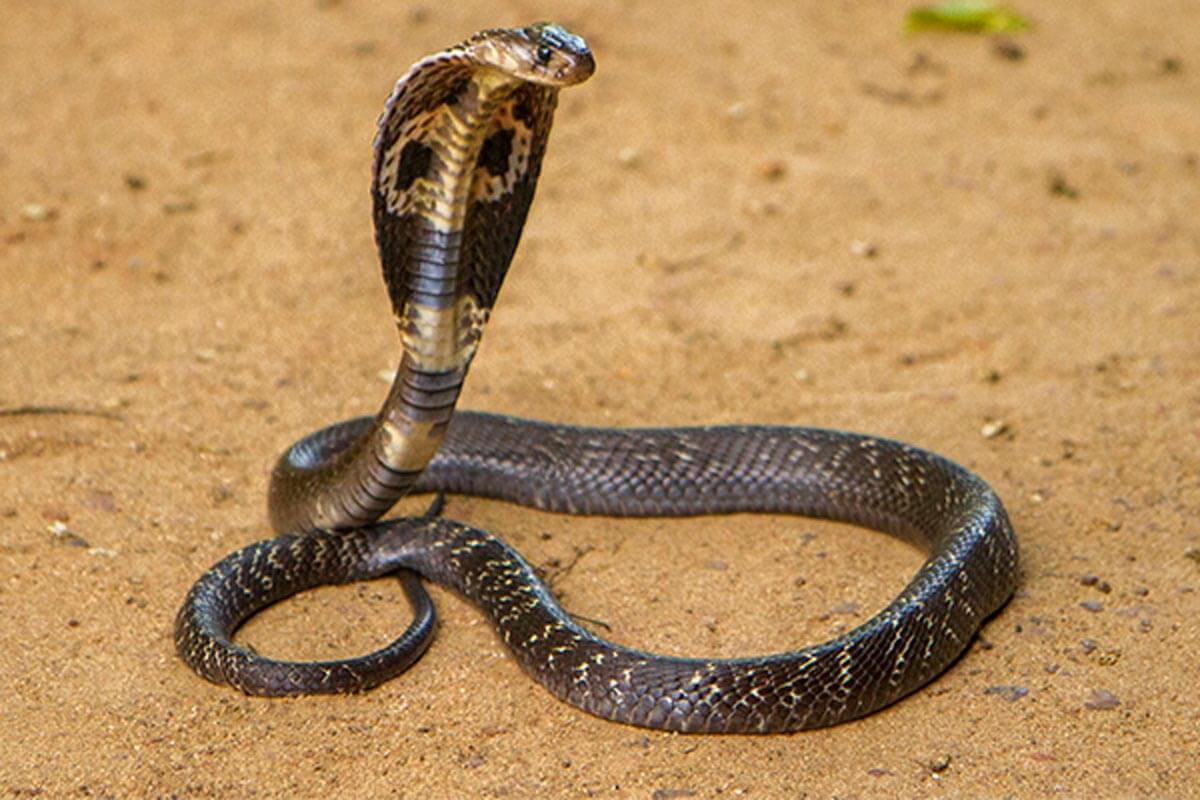
Even well-known mammals can fit into this category. Skunks, for example, are rarely thought of as toxic animals, yet their spray contains sulfur-based compounds that can cause extreme irritation. Animals sprayed directly in the face may suffer intense sneezing, vomiting, temporary blindness, and even damage to red blood cells. While skunks do not inject venom or rely on poison through ingestion, their chemical defense clearly functions as an active toxin delivery system.
This third category highlights how flexible toxin use can be in nature. Evolution has produced solutions that blur simple definitions, creating defenses that sit somewhere between poison and venom.
When animals use more than one strategy
In rare cases, animals do not fit neatly into a single category at all. Some species combine multiple toxin delivery methods, making them both poisonous and venomous at the same time.
Spitting cobras are a well-known example. These snakes can deliver venom through a bite, but they are also capable of spraying venom with remarkable accuracy toward the eyes of a perceived threat. Specialized openings in their fangs allow venom to be expelled as a fine spray, causing intense pain and temporary or permanent blindness. This behavior places them in both the venomous and toxungenous categories.
Certain keelback snakes of Southeast Asia present an even more complex case. These snakes possess venomous bites, yet they also consume poisonous toads. Instead of being harmed by the toxins, keelbacks store the poisons in specialized glands in their necks. When threatened, they secrete these toxins as an additional chemical defense.
Because of these overlapping strategies, the question of whether an animal is poisonous or venomous does not always have a simple answer. In some instances, an animal can be both—using injected venom to subdue prey and stored toxins to discourage predators.
Understanding these distinctions helps clarify how animals survive in hostile environments and reveals just how creative evolution can be when it comes to chemical warfare.

